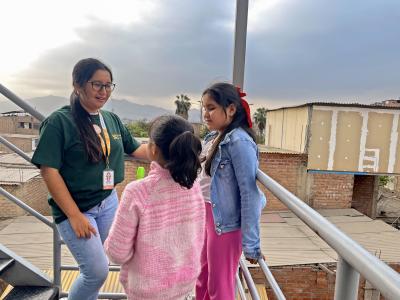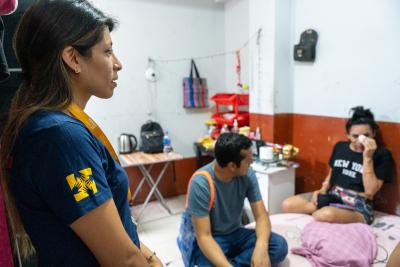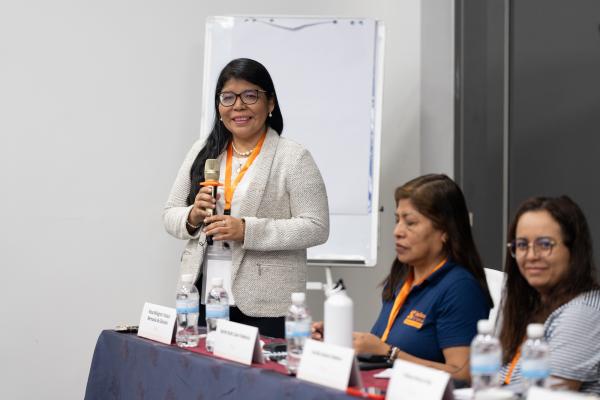Editor’s Note: This blog was originally published in Spanish on Socios En Salud’s blog.
In most health centers, the first person a patient sees isn’t a doctor. Usually, it’s a nurse or midwife. They monitor children’s development, detect preventable diseases, and are pillars of key programming for areas such as mental health, HIV, tuberculosis, and sexual and reproductive health.
Although their role is essential, it’s rarely recognized that—in addition to providing care—these professionals lead teams, drive change, and address critical situations with leadership, empathy, and decision-making skills. Their impact goes beyond the clinical sphere: they are role models for their colleagues and communities.
Therefore, during Nurses Week between May 6 and 12, Socios En Salud (SES), as Partners In Health (PIH) is known in Peru, wanted to highlight the work of nurses and midwives as leaders in community health and underscore the need to strengthen their leadership, mentoring, and decision-making skills to address health system challenges.
Training Health Leaders at the Community Level
“Leadership is something we practice every day, but we’re not always aware of it,” said Rosa Yataco, head of monitoring and evaluation in the SES Program Management Directorate.
For this reason, Socios En Salud implemented a six-month Leadership Skills Training Program specifically for nurses and midwives, which saw participation from 70% of these health professionals at SES.
Leadership in community health allows us to respond to vulnerable populations in areas with limited access to health services. In Peru, nurses and midwives lead in both clinical care and social support. Programs like this one seek to promote transformational leadership with technical and community impact resources starting at the primary care level.
“Many of our colleagues are afraid to take on new opportunities, sometimes because they don’t know how to start. That’s why we decided to create a program that would help them recognize their leadership and prepare them to make decisions in their workplace,” Yataco said.
Yataco led the training program, which consisted of six modules focused on topics such as the fundamentals of leadership in community health, self-leadership and personal management, communication and teamwork, decision-making and problem-solving, ethics and empowerment in leadership, and applied leadership in the community.
For Yataco, ongoing training is key. “A leader isn’t trained overnight; they gain experience and must share it with others, as a mentor, as a peer,” she pointed out.
Leadership in Action: Experiences From the Field
Danna Obregón, midwife and coordinator of the Salud Materno Infantil y Adolescentes, or Maternal, Child, and Adolescent Health program, found that the leadership course allowed her to identify something she had already been doing: leading a team of community health workers.

Danna Obregón meets with families participating in a community intervention for early childhood development.
Photo by Diego Diaz Catire / PIH.
“I was the one with the professional training, but they were the ones who supported people in their daily lives,” Obregón said. “So, my role as a leader was also to provide them with tools and recognize them as agents of change.”
Obregón emphasizes that nurses and obstetricians are already natural leaders: “We are the ones who work directly with the community, who promote health and prevent disease. But that requires preparation and leadership to deal with the unexpected that always appears in the community.”
Jenny Orihuela, a midwife and clinical studies monitor at the Unidad de Ensayos Clínicos (UNEC), or Clinical Trials Unit, adds that leadership is also practiced in technical settings.
“[The training] has allowed me to improve active listening, teamwork, and build trust. And that is essential, because in community health, if people don’t trust you, you can’t help them,” Orihuela shared.
For Orihuela, leadership should not only be applied to work, but also to social transformation: “If I could implement change, it would be through education. If the population is better educated about health, they can take better care of themselves and go to health centers in a timely manner.”
Breaking Stereotypes: Midwives in Invisible Communities
Carla Rodríguez, midwife and coordinator of the HIV and STI program, says that thanks to her role, she has been able to break stereotypes about her profession.
“We tend to associate midwives with childbirth care or the health of women of childbearing age. But today I work with trans women, a population that has historically been excluded from the system,” Rodríguez said.

Carla Rodríguez (left) and her colleagues meet with Daniela, a transgender woman who receives care and support from SES.
Photo by Diego Diaz Catire / PIH.
Through her work, Rodríguez not only provides care but also builds bridges of trust.
“Leading in this context also means raising awareness through the way you speak, how you look at people, and how you address them,” she shared. “It’s a constant challenge because many of them have suffered family and social rejection.”
Her greatest wish: equal opportunities. “Not only in access to health care, but in rights. That’s what can truly change the well-being of these communities.”
Outside of providing community-based care, in rural areas, where doctors are often unavailable, nurses alone also lead care in health centers. Edith Soncco, a nurse at UNEC, emphasizes the importance of teamwork and clear communication to achieve change.
“Nurses don’t just provide care: they organize, direct, and address whatever arises,” she said. “That’s why it’s essential for us to empower them and strengthen their skills.”
The impact of nurses goes beyond their clinical role. By managing programs for infectious diseases, nutrition, or mental health, for example, they are often the only health representatives in underserved communities.
A Future with More Opportunities
The staff at SES can all agree on one thing: leadership is learned, trained, and strengthened through experience and ongoing education.
At Socios En Salud, Nurses Week helps to serve as an opportunity to make visible what is often invisible: the powerful and decisive leadership of nurses and midwives in the health care system.
For Rosa Yataco, awareness and education are just the first steps: “We need more professionals to take the plunge, train, and recognize themselves as leaders. Because in the community, their role is not only clinical. It’s transformative.”
